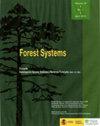Sources of phenotypic variation of wood density and relationships with mean growth in two Eucalyptus species in Argentina
IF 0.7
4区 农林科学
Q3 FORESTRY
引用次数: 0
Abstract
Aims of the study: To describe the radial patterns of wood density, and to identify their main sources of variation, and the potential tradeoffs with mean tree growth, in two Eucalyptus species. Area of study: Mesopotamian (Corrientes and Entre Ríos provinces) and Pampean region (Buenos Aires province) of Argentina. Materials and methods: Eucalyptus grandis and Eucalyptus viminalis, growing in genetic trials installed in two sites per species were studied. X-ray wood microdensity profiles were developed from core samples. Each profile was proportionally divided in 10 sections. Mean, maximum, minimum and the standard deviation of wood density, for each section were computed. Mean annual growth was used to study the relationships with wood microdensity variables. A linear mixed-effects model computed the significance of different sources of phenotypic variation. Pearson´s correlation computed the relationships between variables. Main results: The pattern of radial variation in E. grandis showed a decrease in wood density from pith to bark, mainly due to the decrease in minimum wood density, while in E. viminalis, wood density increased towards the outer wood. In both species, the standard deviation of the wood density increased along the radial profile from pith to bark. Significant variation in wood density was explained by site, provenance and clone/family effects. In E. grandis mean, maximum and minimum wood density were negatively correlated with mean growth, whereas in E. viminalis correlations were positive but close to zero. Research highlights: Both the pattern of radial variation of wood density and the relationship between wood density and mean growth were different in the studied Eucalyptus species, and they varied within species depending on the site they were growing and genetic provenance.阿根廷两种桉树树种木材密度表型变异的来源及其与平均生长的关系
研究目的:描述两种桉树木材密度的径向模式,并确定其主要变异来源,以及与平均树木生长的潜在权衡。研究区域:美索不达米亚(科连特斯省和恩特雷里奥斯省)和阿根廷的潘潘地区(布宜诺斯艾利斯省)。材料和方法:对巨桉和viminalis桉在每种两个地点进行的遗传试验进行了研究。X射线木材微密度剖面是从岩心样品中开发出来的。每个剖面按比例划分为10个部分。计算每个截面的木材密度的平均值、最大值、最小值和标准偏差。年平均生长量用于研究与木材微密度变量的关系。线性混合效应模型计算了表型变异的不同来源的显著性。皮尔逊相关性计算了变量之间的关系。主要结果:大白菜径向变异模式表现出从髓到树皮木材密度的下降,主要是由于最小木材密度的降低,而大白菜的木材密度则向外部木材增加。在这两个物种中,木材密度的标准偏差沿着从髓到树皮的径向剖面增加。木材密度的显著变化由地点、种源和无性系/家族效应来解释。在E.grandis平均值中,最大和最小木材密度与平均生长呈负相关,而在E.viminalis中,相关系数为正,但接近于零。研究重点:在所研究的桉树物种中,木材密度的径向变化模式以及木材密度与平均生长之间的关系都是不同的,而且它们在物种内的变化取决于它们的生长地点和遗传来源。
本文章由计算机程序翻译,如有差异,请以英文原文为准。
求助全文
约1分钟内获得全文
求助全文
来源期刊

Forest Systems
FORESTRY-
CiteScore
1.40
自引率
14.30%
发文量
30
审稿时长
6-12 weeks
期刊介绍:
Forest Systems is an international peer-reviewed journal. The main aim of Forest Systems is to integrate multidisciplinary research with forest management in complex systems with different social and ecological background
 求助内容:
求助内容: 应助结果提醒方式:
应助结果提醒方式:


